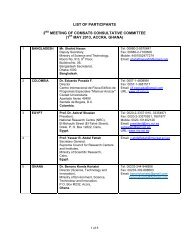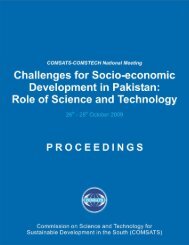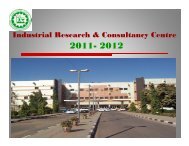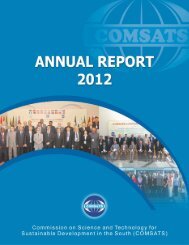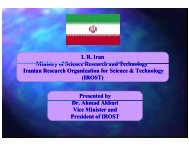Annual Report 2010 - Comsats
Annual Report 2010 - Comsats
Annual Report 2010 - Comsats
Create successful ePaper yourself
Turn your PDF publications into a flip-book with our unique Google optimized e-Paper software.
FOREWORD<br />
By far the most poignant question that confronts<br />
the overwhelming majority of mankind is to know<br />
when the benefits of human development would<br />
be accessible all over the globe, in a reasonably<br />
equitable manner. Unfortunately, much of the<br />
South continues to remain devoid of decent living<br />
conditions available to its vast populations. There<br />
are strong indications that Millennium<br />
Development Goals would not be achieved<br />
uniformly throughout the world. Amid this bleak<br />
landscape, there are islands of prosperity, within<br />
and across nations that have continued to flourish<br />
over the last hundred years. There, the<br />
extravagant life-styles are deeply ingrained,<br />
unmindful of the deprivation faced by humanity at large. The status quo obviously<br />
suits some countries, which also happen to be the ones that control the world<br />
power structure in the form of international institutions, monetary systems, trading<br />
bodies, energy resources and powerful military establishments. It is an open secret<br />
that the rise of rich and strong nations in the modern world can be attributed to their<br />
steadfast devotion to the development of Science and Technology. This recipe can<br />
be seen to give the same results wherever adopted with seriousness, such as in<br />
Japan, S. Korea and China.<br />
It is, therefore, most logical to seek S&T development across the countries of the<br />
South as a means of achieving the ultimate goal of socio-economic development.<br />
There is no easy route for this to happen. The success would depend upon how far<br />
an individual country can overcome internal and external impediments. That is why<br />
the fundamental question of when the world would be, more or less, uniformly<br />
developed is not easy to answer. As seen in the past, the progress would be nonuniform<br />
and time-scales would be widely different, depending on how strong the<br />
commitment is and how much resources are made available by a country’s<br />
leadership, to create the technology savvy society. No progress can be expected if<br />
there is lack of political will and unwillingness to embark upon a long and strenuous<br />
journey. The circumstances that can further hamper any progress are well-known,<br />
such as the adverse effects of climate change, diminishing fossil-fuel resources,<br />
increasing world population, inadequate food and water supplies and continued<br />
specter of military adventurism by states and terrorism by non-state actors.<br />
<strong>Annual</strong> <strong>Report</strong><br />
<strong>2010</strong><br />
Fortunately, there are enough reasons to be optimistic about the world’s future.<br />
The human ingenuity, if directed in the right direction, can bring about<br />
unprecedented positive changes. The tools of Science and Technology can be<br />
effectively employed to mitigate environmental degradation; harness new and<br />
v





